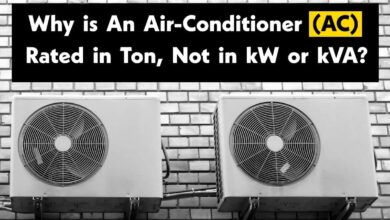In an Inductive Circuit, Why the Current Increases When Frequency Decreases?
Why the Current (I) Decreases, When Frequency Increases in an Inductive Circuit & vise versa?
Another question from electrical and electronics engineering interviews question and answers series.
Explain the statement that “In an Inductive circuit, why the circuit current increases when frequency decreases“.
Related Questions:
- Why Current Increases When Capacitance Increases or Capacitive Reactance Decreases?
- Why Current Decreases When Inductance or Inductive Reactance Increases?
Explanation:
We know that in DC circuits:
I = V / R,
But in case of AC circuits:
I = V / Z
Where “total resistance of AC circuits = Impedance = Z = √ (R2 + (XL – XC2)”
In case of Inductive circuit:
- Z = √ (R2 + XL2)
- I = V / XL or I = V / Z
It shows that in inductive circuit, Current is inversely proportional to the inductance “L” as well as inductive reactance “XL” as inductance and inductive reactances are directly proportional to each others.
Let’s check with an example to see how current reduced by increase in frequency in case of inductive circuit.
When Frequency = 50 Hz
Suppose an inductive circuit where:
- Voltage = V = 3000 V
- Inductance = L = 0.1 Henry
- Resistance = R = 12 Ω
- Frequency = f = 50 Hz
To find the inductive reactance;
XL = 2πfL
XL = 2 x 3.1415 x 50 x 0.1
XL = 31.415 Ω
Now circuit impedance:
Z = √ (R2 + XL2)
Z = √ (122 + 31.4152)
Z = 33.63 Ω
Finally, current in inductive circuit:
I = V / Z
I = 3000 V / 33.63 Ω
I = 89.20 A
Related Questions:
- Why Power Factor Decreases When Inductance or Inductive Reactance Increases?
- Why Power Factor Decreases When Capacitive Reactance Increases or Capacitance Decreases?
When Frequency = 60 Hz
Now we increased the frequency form 50Hz to 60Hz.
V = 3kV, R = 12 Ω, L = 0.1 H, f = 60 Hz.
XL = 2πfL= 2 x 3.1415 x 60 x 0.1 = 37.7 Ω
Z = √ (R2 + XL2) = √ (122 + 37.72) = 39.56 Ω
I = V / Z = 3 kV / 39.56 Ω
I = 75.83 A
Conclusion:
We can see that, When frequency was 50Hz, then the circuit current were 89.20 A,
But when circuit frequency increased from 50Hz to 60Hz, then the current decreased from 89.20 A to 75.83 A.
Hence proved,
In an inductive circuit, when frequency increases, the circuit current decreases and vice versa.
f ∝ 1 / I
In oral or verbal,
- Inductive reactance is a kind of resistance. When resistance increases, the circuit current decreases and vice versa.
- Inductance is directly proportional to the inductive reactance and frequency.
L ∝ f and L ∝ XL
- Current is inversely proportional to the inductance and inductive reactance and impedance.
I ∝ 1 / L and I ∝ 1 / XL and I ∝ 1 / Z
- Impedance is directly proportional to the inductive reactance
Z ∝ XL
- In an inductive circuit, Frequency is inversely proportional to the current
I ∝ 1 / f
Related Questions/Answers:
- Why Flux in Primary and Secondary Winding is Always Equal?
- Why Power in Pure Inductive and Pure Capacitive Circuit is Zero?
- Why the reactance of a system under fault condition is low and faults currents may raise to the dangerously high value?
- Why Inductive Reactance (XL In DC Supply Is Zero (0)?







In inductive ckt
I=v/z
I= 3000/33.63
=89.26 A not 82.20
Thanks for correction. It was type and has been corrected now.
What are the roles of capacitors in electric or electronic circuits ?